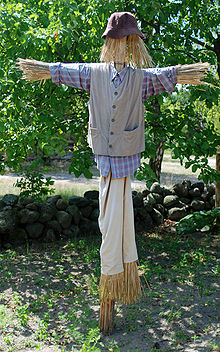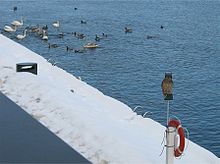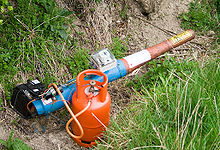- Bird scarer
-
 A traditional scarecrow.
A traditional scarecrow.
A bird scarer is any one of a number devices designed to scare birds, usually employed by farmers to dissuade birds from eating recently planted arable crops.
They are also used on airfields to prevent birds accumulating near runways and causing a potential hazard to jet aircraft.
Contents
Visual scarers
Scarecrow
One of the oldest designs of bird scarer is the scarecrow in the shape of a human figure. The scarecrow idea has been built upon numerous times, and not all visual scare devices are shaped like humans. The "Flashman Birdscarer," Iridescent tape, "TerrorEyes" balloons, and other visual deterrents are all built on the idea of visually scaring birds. This method doesn't work so well with all species, considering that some species frequently perch on scarecrows.
Hawk Kite
Many species of bird are also naturally afraid of predators such as birds of prey. "Hawk Kites" are designed to fly from poles in the wind and hover above the field to be protected. They are shaped to match the sillouette of a bird of prey.
Helikites
The Helikite birdscarer is a lighter-than-air combination of a helium balloon and a kite. Helikites fly up to 200ft in the air with or without wind. Although they do not look like hawks, they fly and hover high in the sky behaving like birds of prey. Helikites successfully exploit bird pests' instinctive fear of hawks and can reliably protect large areas of farmland.
Lasers
The use of lasers can be an effective method of bird scaring, although there is some evidence to suggest some birds are "laser-resistant." The equipment is expensive and specialised training is required, adding to the costs. As the effectiveness of the laser decreases with increasing light levels, it is likely to be most effective at dawn and dusk. Its usefulness may therefore be confined to night time roosts and feeding sites at dawn.
The method relies on Birds being startled by the strong contrast between the ambient light and the laser beam. During low light conditions this technique is very selective and can be attuned to frequencies and wavelengths that individual bird species don't like, but at night the light beam is visible over a large distance and can cause widespread (non-species specific) disturbance.
Dead Birds
The use of model or actual dead birds is used to signal danger to others. Initially birds often approach the corpse but usually leave when they see the unnatural position of the bird. This approach has been frequently used in attempts to deter gulls from airports.
Balloons
An example of a visual bird-scare balloon
Balloons are an inexpensive deterrent. However, this method relies on the movement of balloons, which is something that birds can become used to. The addition of eye illustrations on the balloons has been shown to increase this method's effectiveness as it combats the birds' ability to adapt. Commercially available "scare-eye" balloons have holographic eyes that follow birds wherever they go. The long-term effectiveness of this method can be increased by periodically moving the placement of the scare devices.
In the United Kingdom the use of balloons is subject to approval from the Civil Aviation Authority, especially around airfields.
Auditory scarers
Propane Cannons (propane gas guns)
Towards the end of the 20th century, one of the most popular types of bird scarer used by farmers in Europe and America is the propane powered gas gun which produces a periodic loud explosion. The audible bang can reach volumes in excess of 150 decibels near the gun.
One of the problems with gas gun scarers is that the loud bangs can also irritate people living on nearby properties, or other people using the countryside. Also, birds adapt quickly to any sound that does not randomize its magnitude, pitch, or time interval. Propane cannons become ineffective after a short while.
Electronic Repellers (digitally recorded distress sounds)
One of the most effective sonic repellers on the market. Usually consisting of a central unit and several speakers, the system emits the distress calls, and, if it is a quality product, calls of predators of the target species as well. Effective emitters randomize pitch, magnitude, time interval, sound sequence and other factors to prevent birds from getting used to them.
Ultrasonic scarers
Ultrasonic scarers are electronic devices that produce high pitch emissions ultrasound. The sound is designed to be too high pitched for people to hear, but audible to most birds. This has the advantage to preventing disturbance to neighbouring households. However, these can be heard by some people, particularly females and the young, and although this ability is generally lost with age it can cause discomfort and even headaches for those in proximity who have sensitive high-range hearing. Certain Ornithologists claim that many "pest birds" have a hearing sensitivity similar to that of humans and that the efficiency of ultrasonic bird scarers is not scientifically possible.
Cartridge scarers
Cartridge scarers include a wide variety of noise-producing cartridges usually fired from rockets or rope bangers, or on aerodromes from modified pistols or shotguns, which produce a loud bang and emit flashes of light. They include shellcrackers, screamer shells and whistling projectiles, exploding projectiles, bird bangers and flares.
Cartridges are projected from a shotgun with a range of 45-90m, or pistol (range approximately 25m), and then explode. Bird scaring cartridges can produce noise levels of up to 160dB at varying ranges but both the cartridges and the gun require a firearms certificate in some countries.
Pyrotechnics have proved effective in dispersing birds at airports, landfill sites, agricultural crops and aquaculture facilities. At airports in the UK, shellcrackers fired from a modified pistol are the most common means of dispersing birds, as they allow the bird controller to have some directional control over birds in flight, so they can be steered away from runways.
However, as with all similar noises, there is a high risk of birds becoming used to any pyrotechnics or cartridge explosions.
Other
Dogs
The control of birds and other wildlife such as deer through harassment by trained border collies has been used at aerodromes, golf courses and agricultural land. The dogs represent an actual threat, and so elicit flight reactions. Habituation is unlikely as they can continually pursue and change their behaviour. Border collies are used as they are working dogs bred to herd animals and to avoid attack, and they respond well to whistle and verbal commands. A single border collie and its handler can keep an area of approximately 50 square kilometres free of larger birds and wildlife and although they are effective at deterring ground foraging birds such as waders and wildfowl, they are not so useful for species that spend most of their time flying or perching, such as raptors and swallows.
In 1999 Southwest Florida International Airport became the first commercial airport in the world to employ a border collie in an airfield wildlife control programme. After the use of the collie, numbers and species of birds on the airport declined and most birds that remained congregated in a drainage ditch away from the runway. The number of bird strikes dropped to zero compared to 13 for the same period the previous year. Several other airports and airbases have now started similar programmes.
At Dover Air Force Base, Delaware, bird strike damage to aircraft caused by birds has been reduced from an average of US $600,000 / year for the proceeding two years to US$24 000/year after the initiation of a bird control programme that included the use of border collies.
The problem with border collies, however, is that the underlying problem of any bird infestation is not being solved: the birds find the area attractive. The birds temporarily find the area unattractive when the dog is there, but the second the dog leaves the birds will probably come back. This creates a situation in which the dogs must be consistently employed as long as the area is to be kept free of birds, resulting in high and persistent labor costs.
Predators
The success of this method of bird control is based on the fact that many birds have a natural fear of falcons and hawks as predators, so their presence in the area encourages problem species to disperse. The natural reaction of most prey species is to form a flock and attempt to fly above the falcon. If this fails, they will attempt to fly for cover and leave the area.
Radio controlled aircraft
Radio-controlled model aircraft have been used to scare or 'haze' bird pests since the early 1980s, mainly over airfields, but have also been used over agricultural areas, fisheries and landfill sites. This method has been shown to be very effective and birds habituate more slowly to a treatment in which they are being actively hazed. At Whiteman Air Force Base, Missouri, balsa wood radio-controlled aircraft are one of the primary bird harassment methods used to keep the airfield clear of raptors and other large birds, and they have also proved effective at dispersing the base’s redwing blackbird roost.
Fireworks
Fireworks can also be used as bird scarers, and some jurisdictions issue special licenses for agricultural fireworks.[1] This practice has been criticized as a loophole for the sale for consumer fireworks.[2]
Combination Scarers
These combine multiple deterrents, such as using a pop up scarecrow combined with a gas gun, which in turn activates the distress call of a bird. These combination scarers are often managed by computers and synchronised across an area via the use of radio links.
References
- J. Bishop, H. McKay, D. Parrott, J. Allan (2003). "Review of international research literature regarding the effectiveness of auditory bird scaring techniques and potential alternatives." (PDF). DEFRA. http://www.defra.gov.uk/environment/quality/noise/research/birdscaring/birdscaring.pdf. Retrieved 2007-01-30.
External links
- NFU online Code of Practice for using bird scarers.
Categories:- Agricultural machinery
- Bird pest control
- Fear
Wikimedia Foundation. 2010.


